SERION ELISA classic Influenza A Virus IgG/IgA and Influenza B ...
SERION ELISA classic Influenza A Virus IgG/IgA and Influenza B ...
SERION ELISA classic Influenza A Virus IgG/IgA and Influenza B ...
Create successful ePaper yourself
Turn your PDF publications into a flip-book with our unique Google optimized e-Paper software.
<strong>SERION</strong> <strong>ELISA</strong> <strong>classic</strong><strong>Influenza</strong> A <strong>Virus</strong> <strong>IgG</strong>/<strong>IgA</strong> <strong>and</strong> <strong>Influenza</strong> B <strong>Virus</strong> <strong>IgG</strong>/<strong>IgA</strong>CONTENTS1. INTENDED USE: For sale in the U.S. for Research Use Only. Not for use in diagnosticprocedures.2. BACKGROUND3. <strong>SERION</strong> <strong>ELISA</strong> <strong>classic</strong> - TEST PRINCIPLE4. COMPONENTS OF THE KIT5. MATERIAL REQUIRED BUT NOT SUPPLIED6. STORAGE AND STABILITY7. TEST PROCEDURE <strong>SERION</strong> <strong>ELISA</strong> <strong>classic</strong>7.1 Evidence of deterioration7.2 Sample preparation <strong>and</strong> storage7.3 Preparation of kit reagents7.4 Overview - test procedure7.5 Test procedure8. TEST EVALUATION8.1 Single-point quantification with the 4PL method8.2 Criteria of validity8.3 Calculation <strong>SERION</strong> <strong>ELISA</strong> <strong>classic</strong><strong>Influenza</strong> A <strong>Virus</strong> <strong>IgG</strong>/<strong>IgA</strong> (quantitative) <strong>and</strong><strong>Influenza</strong> B <strong>Virus</strong> <strong>IgG</strong>/<strong>IgA</strong> (quantitative)9. STATEMENTS OF WARNING9.1 Statements of warning9.2 Disposal10. BIBLIOGRAPHYenglish 1
<strong>SERION</strong> <strong>ELISA</strong> <strong>classic</strong><strong>Influenza</strong> A <strong>Virus</strong> <strong>IgG</strong>/<strong>IgA</strong> <strong>and</strong> <strong>Influenza</strong> B <strong>Virus</strong> <strong>IgG</strong>/<strong>IgA</strong>Enzyme Immunoassay for detection of human antibodies (<strong>IgG</strong>/<strong>IgA</strong>)For sale in the U.S. for Research Use Only. Not for use in diagnosticprocedures.<strong>Influenza</strong> A <strong>Virus</strong> <strong>IgG</strong>-Kit (quantitative) order number: ESR1231G<strong>Influenza</strong> A <strong>Virus</strong> <strong>IgA</strong>-Kit (quantitative) order number: ESR1231A<strong>Influenza</strong> B <strong>Virus</strong> <strong>IgG</strong>-Kit (quantitative) order number: ESR1232G<strong>Influenza</strong> B <strong>Virus</strong> <strong>IgA</strong>-Kit (quantitative) order number: ESR1232ATests evaluated: Dade Behring BEP ® III / BEP ® 2000, DSX, manually1. INTENDED USE<strong>SERION</strong> <strong>ELISA</strong> <strong>classic</strong> <strong>Influenza</strong> A <strong>Virus</strong> or B <strong>Virus</strong> <strong>IgG</strong>/<strong>IgA</strong> are quantitative <strong>and</strong>qualitative tests for detection of human antibodies in serum or plasma against <strong>Influenza</strong> A<strong>Virus</strong> or B <strong>Virus</strong>. For sale in the U.S. for Research Use Only. Not for use in diagnosticprocedures.2. BACKGROUND<strong>Influenza</strong> is caused by the orthomyxovirus family of viruses which can be subdivided intogenus specific types A, B <strong>and</strong> C. These viruses primarily consist of a lipid membraneencapsulating the genetic material in the form of a nucleocapsid. In the case of <strong>Influenza</strong>types A <strong>and</strong> B, two specific glycoproteins protrude from the membrane. Theseglycoproteins are the neuraminidase <strong>and</strong> hemagglutinin (N <strong>and</strong> HA respectively) <strong>and</strong> arelinked within the envelope to the virus matrix protein (M) located below the membrane.<strong>Influenza</strong> C virus has only one membrane glycoprotein.<strong>Influenza</strong> viruses are characterised by a distinctive genetic variability, a result of a highmutation frequency <strong>and</strong> an ability to exchange genetic material with other influenza virusstrains by virtue of their segmented genomes. Point mutations gradually increase thegenetic variability resulting in antigenic drift <strong>and</strong> minor changes in the N <strong>and</strong> HA proteins<strong>and</strong> typically contribute to the endemic nature of the virus <strong>and</strong> regular epidemics of diseaseas immunity to the emerging antigenic variation wanes in the population.The ability of the virus to exchange genetic information when more than one virus infectsthe same host results in more dramatic changes in the antigenic make-up of the virus <strong>and</strong> isknown as “antigenic shift“. This phenomenon is responsible for the occurrence of periodicp<strong>and</strong>emics of influenza disease such as in 1957 (<strong>Influenza</strong> A subtype H2N2) <strong>and</strong> 1968(<strong>Influenza</strong> A subtype H3N2).<strong>Influenza</strong> viruses are ubiquitous <strong>and</strong> are globally a significant cause of disease. The mainreservoirs for the virus are man <strong>and</strong> a wide variety of other mammals <strong>and</strong> birds in the caseof <strong>Influenza</strong> A. The occurrence in pigs <strong>and</strong> domestic birds presents a particular problem insome cultures <strong>and</strong> aids the process of antigenic shift. <strong>Influenza</strong> B infects only humans while<strong>Influenza</strong> type C is rarely encountered <strong>and</strong> has been isolated from both humans <strong>and</strong> pigs.english 2
<strong>Influenza</strong> is an acute <strong>and</strong> highly contagious infection affecting the respiratory tract withtransmission being effected by aerosol. The symptoms of infection are variable rangingfrom asymptomatic to acute respiratory distress <strong>and</strong> death. Sudden onset of symptoms istypical <strong>and</strong> <strong>classic</strong> symptoms include fever, cough, headache <strong>and</strong> muscle aches alldeveloping within a few hours.Particular sections of the community are particularly at risk of developing severe disease<strong>and</strong> prophylactic measures are recommended for those suffering from immunosuppressionor metabolic diseases in addition to the elderly. Respiratory damage from <strong>Influenza</strong>infection may facilitate a bacterial superinfection resulting in pneumonia, <strong>and</strong> in some casesprimary <strong>Influenza</strong> pneumonia may rapidly cause death.An early diagnosis of infection may be effected using tests which directly detect thepathogen in patient samples such as nose <strong>and</strong> throat swabs <strong>and</strong> nasopharyngeal rinses.<strong>ELISA</strong> <strong>and</strong> IFT assays exist for direct pathogen/antigen detection <strong>and</strong> tend to be morerapid than isolation <strong>and</strong> identification of the agent in cell culture.Serological tests for immunological evidence of infection include <strong>ELISA</strong> <strong>and</strong> CFT. Thesetests are a reliable method for identifying the serological type of the pathogen. In addition itis possible to differentiate between immunoglobulin classes with the <strong>ELISA</strong> format.3. <strong>SERION</strong> <strong>ELISA</strong> <strong>classic</strong> - TEST PRINCIPLEMicrotiter wells are coated with antigens. This constitutes the solid phase. Sample isadded to the wells <strong>and</strong> any antibodies specific for the antigen present will bind to the solidphase. After removal of unbound material, anti-human <strong>IgG</strong> or <strong>IgA</strong> or IgM conjugated toan enzyme (alkaline phosphatase) is allowed to react with the immune complex. Afterremoval of excess conjugate by washing, an appropriate substrate (paranitrophenylphosphate)is added, with which the conjugated enzyme reacts producing acolored derivative of the substrate. The color intensity is proportional to the level ofspecific antibody bound <strong>and</strong> can be quantified photometrically.english 3
4. COMPONENTS OF THE KITTest components amount /volumeBreak apart microtiter test strips each with 8 antigen coated single wells (altogether 96),1 frame12the coating material is inactivatedSt<strong>and</strong>ard serum (ready-to-use)2 x 2 mlHuman serum in phosphate buffer with protein; negative for anti-HIV-Ab, HBs-Ag (HepatitisB-<strong>Virus</strong>-surface antigen) <strong>and</strong> anti-HCV-Ab; preservative: < 0.1% sodium azidecolouring: Amaranth ONegative control serum (ready-to-use)2 mlHuman serum in phosphate buffer with protein; negative for anti-HIV-Ab, HBs-Ag (HepatitisB-<strong>Virus</strong>-surface antigen) <strong>and</strong> anti-HCV-Ab; preservative: < 0.1% sodium azidecolouring: Lissamine green VAnti-human-<strong>IgG</strong>-, <strong>IgA</strong>-, IgM-conjugate (ready-to-use)13 mlAnti-human-<strong>IgG</strong>, -<strong>IgA</strong>, -IgM from goat (polyclonal), conjugated to alkaline phosphatase,stabilized with protein stabilization solutionpreservative: 0.01 % methylisothiazolone, 0.01 % bromnitrodioxaneWashing solution concentrate (sufficient for 1000ml)33.3 mlSodium chloride solution with Tween 20, 30 mM Trispreservative: < 0.1% sodium azideDilution buffer2 x 50 mlPhosphate buffer with protein <strong>and</strong> Tween 20;preservative: < 0.1% sodium azide0.01 g/l Bromphenol blue sodium saltStopping solution15 ml1.2 N sodium hydroxideSubstrate (ready-to-use)13 mlPara-nitrophenylphosphate, solvent free bufferpreservative: < 0.1 % sodium azide(Substrate in unopened bottle may have a slight yellow coloring. This does not reduce thequality of the product!)Quality control certificate with st<strong>and</strong>ard curve <strong>and</strong> evaluation table1(quantification of antibodies in IU/ml or U/ml)5. MATERIAL REQUIRED BUT NOT SUPPLIED- common laboratory equipment- for the IgM-<strong>ELISA</strong>: <strong>SERION</strong> Rf-Absorbent (Order no. Z200/20ml)- photometer for microtiter plates with filter, wave length 405 nm, recommendedreference wave length 620 nm - 690 nm (e.g. 650 nm)- incubator 37°C- moist chamber- distilled waterenglish 4
6. STORAGE AND STABILITYReagent Storage Stabilitymicrotiter strips(antigen)control sera /st<strong>and</strong>ard seraconjugatedilution bufferwashing solutionsubstrateafter opening at 2-8°C in closed aluminum-bag withdesiccantstrips which are not used must be stored in the press-seal bagof aluminum compound foil under dry <strong>and</strong> airtightconditions!after opening at 2-8°Cready-to-use solution, at 2-8°CAvoid contamination (sterile tips!)after opening at 2-8°CDiscard cloudy solutions!unopenedconcentrate after opening at 2-8°Cworking dilution at 2-8°Cworking dilution at room temperaturebottles used for the working dilution should be cleanedregularly, discard cloudy solutionsready-to-use solution at 2-8°C, protected from light!Avoid contamination (sterile tips!) Discard when solutionturns yellow (extinction against distilled water. > 0.25).4 weeksuntil expiry date;24 months fromdate of productionuntil expiry date28 months fromdate of production24 monthsuntil expiry date;36 months fromdate of productionuntil expiry date2 weeks1 weekuntil expiry date24 months fromdate of productionstopping solution after opening at room temperature until expiry date7. TEST PROCEDURE <strong>SERION</strong> <strong>ELISA</strong> <strong>classic</strong>7.1 Evidence of deteriorationOnly use <strong>SERION</strong> <strong>ELISA</strong> <strong>classic</strong> reagents for test procedure, since all reagents are matched.In particular st<strong>and</strong>ard <strong>and</strong> control sera are defined exclusively for the test kit to be used. Donot use them in other lots. Dilution buffer, washing solution <strong>and</strong> substrate solution can beused for all <strong>SERION</strong> <strong>ELISA</strong> <strong>classic</strong> kits irrespective of the lot <strong>and</strong> the test.There are three different conjugate concentrations for each immunoglobulin class: LOW,MEDIUM, HIGHenglish 5
The classification is written on each label as follows:e.g.<strong>IgG</strong> + lowly concentrated <strong>IgG</strong> conjugate<strong>IgG</strong> ++ medium concentrated <strong>IgG</strong> conjugate<strong>IgG</strong> +++ highly concentrated <strong>IgG</strong> conjugateIn rare cases the use of special conjugate is necessary to guarantee consistent quality for ourproducts. Special conjugates are produced in a separate lot <strong>and</strong> do not wear the “+” sign.Therefore, special conjugates are not exchangeable with other conjugates.Please pay close attention to notifications on labels!Unopened, all components of the <strong>SERION</strong> <strong>ELISA</strong> <strong>classic</strong> kits may be used up to the datesgiven on the labels, if stored at +2°C to +8°C. Complete stability <strong>and</strong> storage data aredescribed under “6. Storage <strong>and</strong> Stability”.Each reagent has been calibrated <strong>and</strong> optimized for the test. Dilution or alteration of thesereagents may result in a loss of sensitivity.Avoid exposure of reagents to strong light during storage <strong>and</strong> incubation. Reagents mustbe tightly closed to avoid evaporation <strong>and</strong> contamination with microorganisms sinceincorrect test results could occur due to interference from proteolytic enzymes.To open the press-seal bag please cut off the top of the marked side, only. Do not use thestrips if the aluminum bag is damaged or if the press-seal bag with remaining strips <strong>and</strong>desiccant was not properly closed.Bring all reagents to room temperature before testing.Use aseptic techniques for removing aliquots from the reagent tubes to avoidcontamination. To avoid false positive results ensure not to contact or sprinkle the top-wallsof wells while pipetting conjugate. Take care not to mix the caps of the bottles <strong>and</strong>/or vials.Reproducibility is dependent on thorough mixing of the reagents. Shake the flaskscontaining control sera before use <strong>and</strong> also all samples after dilution (e.g. by using amonomixer).Be sure to pipette carefully <strong>and</strong> comply with the given incubation times <strong>and</strong> temperatures.Significant time differences between pipetting the first <strong>and</strong> last well of the microtiter platewhen filling samples/control sera, conjugate or substrate may result in different “preincubation” times, which may influence the precision <strong>and</strong> reproducibility of the results.Optimum results can only be achieved if <strong>SERION</strong> <strong>ELISA</strong> <strong>classic</strong> instructions are followedstrictly.The test is not valid, if the lot-specific validation criteria on the quality control certificate arenot fulfilled.Inadequate washing will affect the test results:The washing procedure should be carried out carefully. If the washing procedure is carriedout automatically follow the instruction manual of the respective washer. Flat bottom wellsare used for <strong>SERION</strong> <strong>ELISA</strong> <strong>classic</strong>. All wells should be filled with equal volumes ofwashing buffer. At the end of the procedure ensure that the wells are free of all washingbuffer by tapping the inverted microtest plate on a paper towel. Avoid foam! Do not scratchenglish 6
coated wells during washing <strong>and</strong> aspiration. If using an automated washer, ensure it isoperating correctly.7.2 Sample preparation <strong>and</strong> storageLipaemic, hemolytic or icteric samples should only be tested with reservations although inour testing no negative influence has been found. Obviously contaminated samples (serumor plasma) should not be tested due to the risk of wrong results.Serum or plasma (EDTA, citrate, heparin) collected according to st<strong>and</strong>ard laboratorymethods are suitable samples.Samples must not be thermally inactivated.7.2.1 Sample preparationBefore running the test, samples must be diluted in dilution buffer (V 1 + V 2) as follows:<strong>IgA</strong>V 1 + V 2 = 1+5005 µl sampleplus 500 µl dilution buffer (= 1+100)50 µl from the first dilution stepplus 200 µl dilution buffer (= 1+4)<strong>IgG</strong>V 1 + V 2 = 1+20005 µl sampleplus 500 µl dilution buffer (= 1+100)25 µl from the first dilution stepplus 500 µl dilution buffer (= 1+20)After dilution <strong>and</strong> before pipetting into the microtiter plate the samples must be mixedthoroughly to prepare a homogenous solution.Rheumatoid factor-interference:Rheumatoid factors are auto-antibodies mainly of the IgM-class, which preferably bind to<strong>IgG</strong>-immune-complexes. The presence of non-specific IgM-antibodies (rheumatoid factors)can lead to false-positive results in the IgM-assay. Furthermore, the possibility exists, thatweak-binding pathogen-specific IgM-antibodies are displaced by stronger-binding <strong>IgG</strong>antibodies.In this case, IgM-detection can lead to false-negative results. Therefore it isnecessary to pretreat samples with rheumatoid factor-absorbens prior to IgM detection(<strong>SERION</strong> Rheumatoid Factor-Absorbent, Order-No. Z4 (4ml/20 tests) / Z200 (20ml/100tests)).english 7
7.2.2 Sample storageThe samples can be stored in a refrigerator up to 7 days at 2-8°C. Extended storage ispossible at ≤ -20°C.Avoid repeated freezing <strong>and</strong> thawing of samples.Diluted samples can be stored at 2-8°C for one week.7.3 Preparation of kit reagents7.3.1 Microtest stripsMicrotest strips in frame are packed with desiccant in an aluminum bag. Takeunrequired cavities out of the frame <strong>and</strong> put them back into the press-seal bag. Closepress-seal bag carefully to ensure airtight conditions.7.3.2 Control sera / st<strong>and</strong>ard seraControl <strong>and</strong> st<strong>and</strong>ard sera are ready-to-use <strong>and</strong> must not be diluted any further. Theycan be used directly for the test run.For each test run <strong>and</strong> for each test system - independent of the number of microteststrips to be used - control <strong>and</strong> st<strong>and</strong>ard sera must be included. The cut-off-controlshould be set up in duplicate. With the quantitative tests the st<strong>and</strong>ard serum shouldalso be set up in duplicate.Do not treat control sera with Rf-absorbent.7.3.3 Anti-human-<strong>IgG</strong>-, IgM- or <strong>IgA</strong>-AP-conjugate (ready-to-use)Please do not mix up conjugates from different kits. They are optimized for each lot.Conjugates are exchangeable as described in 7.1.Avoid contamination of ready-to-use conjugates (please pour sufficient for test into asecondary container to avoid repeatedly pipetting from the original bottle).7.3.4 Washing solutionDilute washing buffer concentrate (V 1) 1:30 with distilled water to a final volume ofV 2.Example:buffer concentrate (V 1) final volume (V 2)33.3 ml 1000 ml1 ml 30 ml7.3.5 Dilution buffer for samples (ready-to-use)7.3.6 Substrate (ready-to-use)To avoid contamination use gloves. For pipetting substrate solution use sterile tipsonly!7.3.7 Stopping solution (ready-to-use)english 8
7.4 Overview - test procedure<strong>Influenza</strong> A /B <strong>Virus</strong>quantitativesample dilution<strong>IgA</strong>: 1 + 500<strong>IgG</strong>: 1+2000Pipette diluted samples <strong>and</strong> ready-to-use control sera /st<strong>and</strong>ard sera into the microtest wells (100 µl)INCUBATION 60 min./ 37°Cmoist chamberWASHPipette conjugate solution (100 µl)INCUBATION 30 min./ 37°Cmoist chamberWASHPipette substrate solution (100µl)INCUBATION 30 min./ 37°Cmoist chamberPipette stopping solution (100 µl)READ EXTINCTION AT 405 nmenglish 9
7.5 Test procedure1. Place the required number of cavities in the frame <strong>and</strong> prepare a protocol sheet.2. Add each 100 µl of diluted sample or ready-to-use controls into the appropriate wellsof microtest strips. Spare one well for substrate blank, e.g.:<strong>IgG</strong>/<strong>IgA</strong> quantitativeantigen cavitieswell A1 substrate blankwell B1 negative controlwell C1 st<strong>and</strong>ard serumwell D1 st<strong>and</strong>ard serumwell E1 sample 1....3. Sample incubation for 60 minutes (+/- 5 min) at 37°C (+/- 1°C) in moist chamber4. After incubation wash all wells with washing solution (by automated washer ormanually):- aspirate or shake out the incubation solution- fill each well with 300 µl washing solution- aspirate or shake out the washing buffer- repeat the washing procedure 3 times (altogether 4 times!)- dry by tapping the microtest plate on a paper towel5. Addition of conjugateAdd 100 µl of <strong>IgG</strong>-/IgM-/<strong>IgA</strong>-conjugate (ready-to-use) to the appropriate well (exceptsubstrate blank)6. Conjugate incubation for 30 minutes (+/- 1 min) * at 37°C (+/- 1°C) in moist chamber.7. After incubation wash all wells with washing solution (see above)8. Addition of substrateAdd 100 µl substrate solution (ready-to-use) to each well (including well for substrateblank!)9. Substrate incubation for 30 minutes (+/- 1 min) * at 37°C (+/- 1°C) in moist chamber.10. Stopping of the reactionAdd 100 µl stopping solution to each well, shake microtest plate gently to mix.11. Read optical densityRead OD within 60 minutes at 405 nm against substrate blank, reference wave lengthbetween 620 nm <strong>and</strong> 690 nm (e.g. 650 nm).* Please note, that under special working-conditions internal-laboratory adaptations of the incubation timescould be necessary.english 10
8. TEST EVALUATION <strong>SERION</strong> <strong>ELISA</strong> <strong>classic</strong><strong>Influenza</strong> A <strong>Virus</strong> <strong>IgG</strong>/<strong>IgA</strong> (quantitative) <strong>and</strong> <strong>Influenza</strong> B <strong>Virus</strong><strong>IgG</strong>/<strong>IgA</strong>(quantitative)8.1 Single-point quantification with the 4PL methodOptimized assignment of extinction signals to quantitative values is guaranteed by usingnon-linear functions, which adjust a sigmoide curve without any further transformation toOD-values.Determination of antibody concentrations with the <strong>SERION</strong> <strong>ELISA</strong> <strong>classic</strong> is carried out bythe logistic-log-model (4 PL; 4 parameter) which is ideal for exact curve-fitting. It is basedon the formula:OD = A +1 + eD - AB(C -ln conc.)The parameters A, B, C, <strong>and</strong> D are representative for the exact shape of the curve:1. lower asymptote parameter A2. slope of the curve parameter B3. turning point parameter C4. upper asymptote parameter DFor each lot the st<strong>and</strong>ard curve is evaluated by Institut Virion\Serion GmbH (Würzburg,Germany) in several repeated test runs under optimal conditions. Time consuming <strong>and</strong> costintensive construction of the st<strong>and</strong>ard curve by the user is not necessary.For evaluation of antibody concentrations a lot specific st<strong>and</strong>ard curve as well as a lotspecific evaluation table is included with each test kit. Appropriate evaluation software isavailable on request.To compensate for normal test variations <strong>and</strong> also for test run control a st<strong>and</strong>ard serum isused in each individual test run. For this control serum a ‘’reference value’’ with a validityrange is determined by the quality control of the producer. Within this range a correctquantification of antibody concentration is ensured. Since the st<strong>and</strong>ard serum is notnecessarily a positive control, the value of the st<strong>and</strong>ard serum may be borderline ornegative in some <strong>ELISA</strong> tests.english 11
8.2 Criteria of validity- the substrate blank must be OD < 0.25- the negative control must be negative- quantitative <strong>ELISA</strong>: the mean OD-value of the st<strong>and</strong>ard serum must be within the lotspecific validity range, which is given on the lot specific quality control certificate ofthe kit (after subtraction of the substrate blank!)- qualitative <strong>ELISA</strong>: the mean OD-value of the positive control must be within thevalidity range, which is given on the lot specific quality control certificate of the kit(after subtraction of the substrate blank!)- the variation of OD-values may not be higher than 20%.If these criteria are not met, the test is not valid <strong>and</strong> must be repeated.8.3 Calculation <strong>SERION</strong> <strong>ELISA</strong> <strong>classic</strong><strong>Influenza</strong> A <strong>Virus</strong> <strong>IgG</strong>/<strong>IgA</strong> <strong>and</strong> <strong>Influenza</strong> B <strong>Virus</strong> <strong>IgG</strong>/<strong>IgA</strong> (quantitative)8.3.1 Non-automated evaluationFor the test evaluation a st<strong>and</strong>ard curve <strong>and</strong> an evaluation table are included in the test kitso that the obtained OD-values may be assigned to the corresponding antibody activity.The reference value <strong>and</strong> the validity range of the st<strong>and</strong>ard serum is given on the evaluationtable (quality control certificate).The blank (A1) must be subtracted from all OD-values prior to the evaluation.Method 1: Qualitative EvaluationTo fix the cut-off ranges please multiply the mean value of the measured st<strong>and</strong>ard-OD withthe numerical data of the certificate of quality control (see special case formulas), e.g.:OD = 0.502 x MW(STD) with upper cut-offOD = 0.352 x MW(STD) with lower cut-offIf the measured mean absorbance value of the st<strong>and</strong>ard serum is 0.64, the range of the cutoffis in between 0.225-0.321.Method 2: Continuous determination of antibody activities using the st<strong>and</strong>ard curve.So called interassay variations (day to day deviations <strong>and</strong> laboratory to laboratorydeviations) are compensated by multiplication of the current measured value obtained witha sample with the correction factor F. This factor is calculated as follows:F =OD-reference value (of st<strong>and</strong>ard serum)OD-current value (of st<strong>and</strong>ard serums)The procedure is necessary to adjust the current level of the test of the user with the lotspecificst<strong>and</strong>ard curve.english 12
First, daily deviations are to be corrected by calculating a factor (correction factor F):1. The mean of the two OD-values of the st<strong>and</strong>ard serum has to be calculated <strong>and</strong> checkedthat it is within the given validity range.2. Calculation of the factor "F": the given reference value is divided by the mean of theextinction of the st<strong>and</strong>ard serum:F = reference value extinction st<strong>and</strong>ard serum / mean value extinction st<strong>and</strong>ard serum.3. All measured values of samples are multiplied by "F".4. Antibody activities in IU/ml or U/ml can be determined from the st<strong>and</strong>ard curve withthe corrected values.8.3.2 Automatic test evaluation with<strong>SERION</strong> easy base 4PL-Software/<strong>SERION</strong> evaluate-SoftwareAfter input of the 4 parameters <strong>and</strong> the reference value of the st<strong>and</strong>ard serum, antibodyactivities are calculated online. If the optical density of the st<strong>and</strong>ard is out of the validrange, the following message will appear:<strong>SERION</strong> easy base 4PL-Software:”St<strong>and</strong>ards are not in tolerance range” <strong>and</strong>/or “Distance between st<strong>and</strong>ards is greaterthan 20 %.”<strong>SERION</strong> evaluate-Software:“St<strong>and</strong>ard values out of ranges in following groups: Group 1-24. St<strong>and</strong>ard value differmore than 20% in following groups: Group 1-24.”In these cases the test run is invalid <strong>and</strong> should be repeated.Parameters <strong>and</strong> reference value need to be changed only if there is a change of lot(evaluation table shows parameters <strong>and</strong> reference values). Correct input of the lot specificdata can be checked on the basis of the IU/ml or U/ml assigned to the st<strong>and</strong>ard serum. Thecalculated mean value of the units has to correspond to the unit value indicated on the lotspecific certificate. There is an automatic correction of the measured values. In the st<strong>and</strong>ardversion the printout displays the following:sample codeOD-valueIU/ml or U/mlevaluationenglish 13
9. STATEMENTS OF WARNING9.1 Statements of warningThe <strong>SERION</strong> <strong>ELISA</strong> <strong>classic</strong> is only designed for qualified personnel who is familiar withgood laboratory practice.All kit reagents <strong>and</strong> human specimens should be h<strong>and</strong>led carefully, using established goodlaboratory practice.- This kit contains human blood components. Although all control- <strong>and</strong> cut-off-sera havebeen tested <strong>and</strong> found negative for HBs-Ag-, HCV- <strong>and</strong> HIV-antibodies, they should beconsidered potentially infectious.- Do not pipette by mouth.- Do not smoke, eat or drink in areas in which specimens or kit reagents are h<strong>and</strong>led.- Wear disposable gloves, laboratory coat <strong>and</strong> safety glasses while h<strong>and</strong>ling kit reagentsor specimens. Wash h<strong>and</strong>s thoroughly afterwards.- Samples <strong>and</strong> other potentially infectious material should be decontaminated after thetest run.- Reagents should be stored safely <strong>and</strong> be unaccessible to unauthorized access e.g.children.- Stopping solution: corrosive (C); causes acid burn (R34)use safety glasses, gloves <strong>and</strong> laboratory coat while h<strong>and</strong>ling!9.2 DisposalPlease observe the relevant statutory requirements!10. BIBLIOGRAPHYenglish 14
1. Rothbarth, P. H.; Groen, J. Bohnen, A. M.; de Groot, R.; Osterhaus, A.D.M.E.:<strong>Influenza</strong> virus serology-a comparative study.Journal of Virological Methods 78 (1999), 163-1692. Shaw, M. W.; Arden, N. H.; Maassab, H. F.:New Aspects of <strong>Influenza</strong> <strong>Virus</strong>es.Clinical Microbiology Reviews, 5 (1), 74-923. Voeten, J.T.M.; Groen,D.; van Alphen, D.; Claas, E.C.J.; de Groot, R.; Osterhaus,A.D.M.E.; Rimmelzwaan, G.F.:Use of Recombinant Nucleoproteins in Enzyme-Linked Immunosorbent Assays forDetection of <strong>Virus</strong>-Specific Immunglobulin A (<strong>IgA</strong>) <strong>and</strong> <strong>IgG</strong> Antibodies in <strong>Influenza</strong><strong>Virus</strong> A- or B-Infected Patients.Journal of Clinical Microbiology 36 (12), (1998), 3527-35314. Döller, G.; Gerth, H. J.:Evaluierung der Einzelserumdiagnose nach <strong>Influenza</strong>-Infektionen.Lab. med. 15 (1991), 560-5625. Epidemiologisches Bulletin 07/1999Aktuelle Daten und Informationen zu Infektionskrankheiten und Public HealthRatgeber Infektionskrankheiten vom Robert Koch Institut;<strong>Influenza</strong>virus-Infektionen (<strong>Virus</strong>grippe) vom Dezember 1999english 15


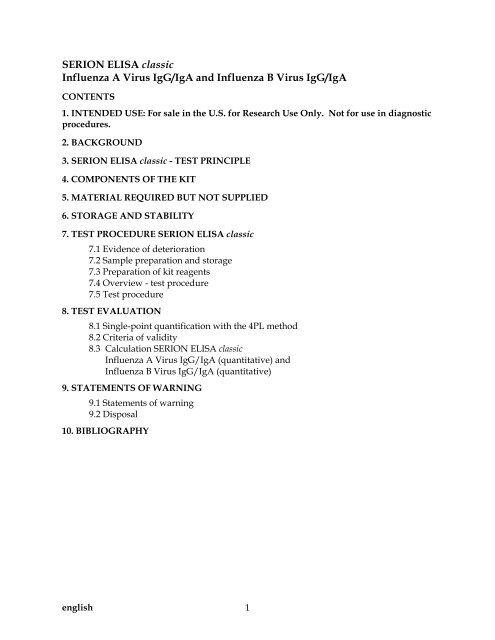

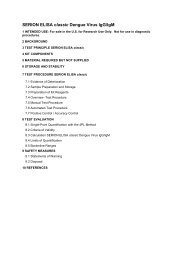
![MIKROGEN recomBlot CMV IgG [Avidity] recomBlot CMV IgM ...](https://img.yumpu.com/47840028/1/185x260/mikrogen-recomblot-cmv-igg-avidity-recomblot-cmv-igm-.jpg?quality=85)
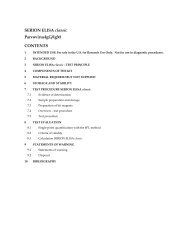
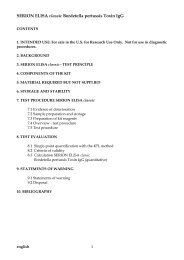

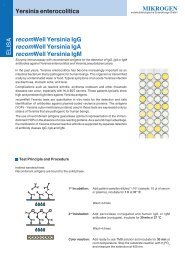
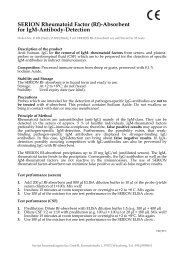

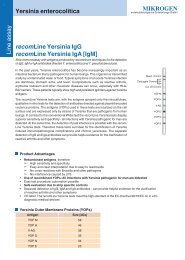
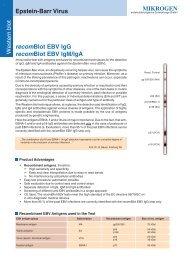
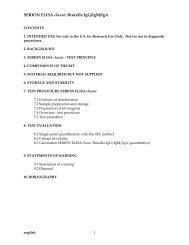

![MIKROGEN recomLine Parvovirus B19 IgG [Avidity] recomLine ...](https://img.yumpu.com/31102785/1/185x260/mikrogen-recomline-parvovirus-b19-igg-avidity-recomline-.jpg?quality=85)